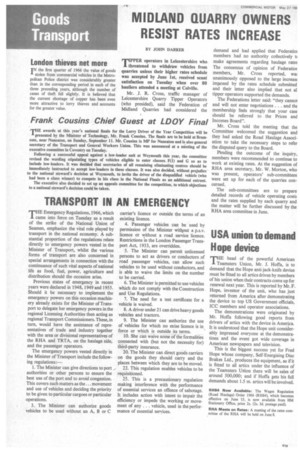TRANSPORT IN AN EMERGENCY
Page 78

If you've noticed an error in this article please click here to report it so we can fix it.
THE Emergency Regulations, 1966, which came into force on Tuesday as a result of the strike of the National Union of Seamen, emphasize the vital role played by transport in the national economy. A substantial proportion of the regulations relate directly to emergency powers vested in the Minister of Transport, whilst the various forms of transport are also concerned in special arrangements in connection with the continuance of such vital aspects of national life as food, fuel, power, agriculture and distribution should the occasion arise.
Previous states of emergency in recent years were declared in 1948, 1949 and 1955. Should it be necessary to implement the emergency powers on this occasion machinery already exists for the Minister of Transport to delegate her emergency powers in the regional Licensing Authorities then acting as regional Transport Commissioners. These, in turn, would have the assistance of representatives of trade and industry together with the area or divisional representatives of the RHA and TRTA, on the haulage side, and the passenger operators.
The emergency powers vested directly in the Minister of Transport include the following regulations:— 1. The Minister can give directions to port authorities or other persons to ensure the best use of the port and to avoid congestion. This covers such matters as the ... movement and use of vehicles and deciding the priority to be given to particular cargoes or particular operations.
3. The Minister can authorize goods vehicles to be used without an A, B or C carrier's licence or outside the terms of an existing licence.
4. Passenger vehicles can be used by permission of the Minister withput a p.s.v. licence or without a road service licence. Restrictions in the London Passenger Transport Act, 1933, are overridden.
5. The Minister can permit unlicensed persons to act as drivers or conductors of road passenger vehicles, can allow such vehicles to be used without conductors, and is able to waive the limits on the number to be carried.
6. The Minister is permitted to use vehicles which do not comply with the Construction and Use Regulations.
7. The need for a test certificate for a vehicle is waived.
8. A driver under 21 can drive heavy goods vehicles and tractors.
9. The Minister can authorize the use of vehicles for which no exise licence is in force or which is outside its terms.
10. She can waive some of the formalities connected with (but not the necessity for) third-party insurance.
20. The Minister can direct goods carriers on the goods they should carry and the places between which they are to be moved.
22. This regulation enables vehicles to be requisitioned.
25. This is a precautionary regulation making interference with the performance of essential services an offence of sabotage. It includes action with intent to impair the efficiency or impede the working or movement of any . . . vehicle, used in the performance of essential services.




































































































































































































































































